OPEL ANTARA 2009 Owners Manual
Manufacturer: OPEL, Model Year: 2009, Model line: ANTARA, Model: OPEL ANTARA 2009Pages: 234, PDF Size: 3.01 MB
Page 141 of 234
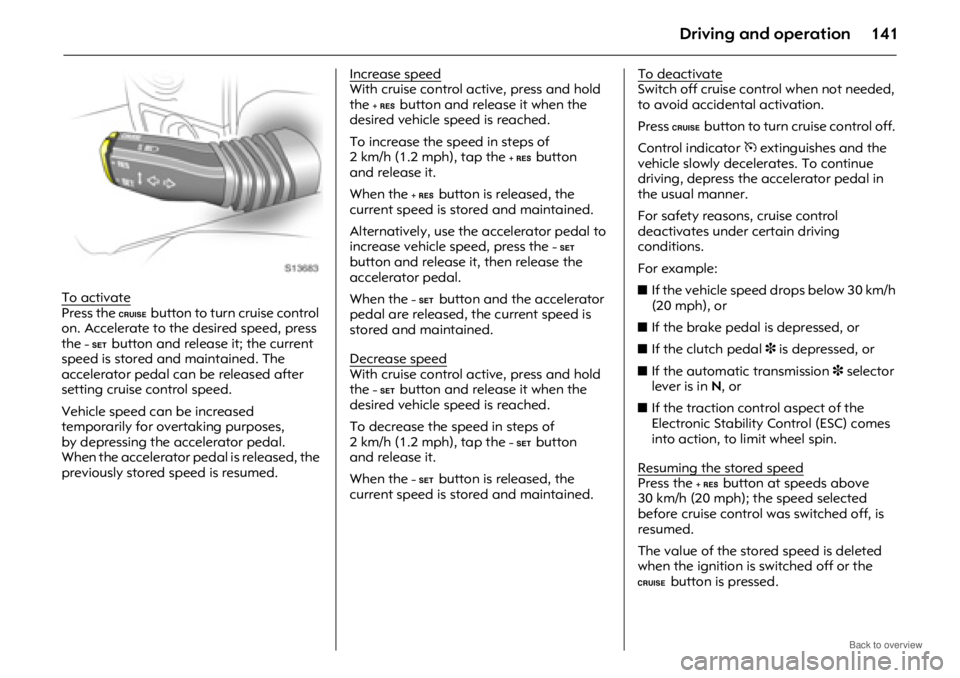
Driving and operation141
To activatePress the e button to turn cruise control
on. Accelerate to the desired speed, press
the
d button and release it; the current
speed is stored and maintained. The
accelerator pedal can be released after
setting cruise control speed.
Vehicle speed can be increased
temporarily for overtaking purposes,
by depressing the accelerator pedal.
When the accelerator pe dal is released, the
previously stored speed is resumed. Increase speed
With cruise control active, press and hold
the c button and release it when the
desired vehicle speed is reached.
To increase the speed in steps of
2 km/h (1.2 mph), tap the
c button
and release it.
When the
c button is released, the
current speed is stored and maintained.
Alternatively, use the accelerator pedal to
increase vehicle speed, press the
d
button and release it, then release the
accelerator pedal.
When the
d button and the accelerator
pedal are released, the current speed is
stored and maintained.
Decrease speed
With cruise control active, press and hold
the d button and release it when the
desired vehicle speed is reached.
To decrease the speed in steps of
2 km/h (1.2 mph), tap the
d button
and release it.
When the
d button is released, the
current speed is stored and maintained. To deactivate
Switch off cruise control when not needed,
to avoid accidental activation.
Press
e button to turn cruise control off.
Control indicator m extinguishes and the
vehicle slowly decelerates. To continue
driving, depress the accelerator pedal in
the usual manner.
For safety reasons, cruise control
deactivates under certain driving
conditions.
For example:
z If the vehicle speed drops below 30 km/h
(20 mph), or
z If the brake pedal is depressed, or
z If the clutch pedal 3 is depressed, or
z If the automatic transmission 3 selector
lever is in N, or
z If the traction control aspect of the
Electronic Stability Control (ESC) comes
into action, to limit wheel spin.
Resuming the stored speed
Press the c button at speeds above
30 km/h (20 mph); the speed selected
before cruise control was switched off, is
resumed.
The value of the stored speed is deleted
when the ignition is switched off or the
ebutton is pressed.
Page 142 of 234

Driving and operation142
Park pilot 3
The park pilot makes parking easier by
measuring the distance between the
vehicle and any obstacles to the front and
rear and giving an acoustic signal in the
passenger compartment.
The system records the distance using four
sensors in both the front and rear bumpers.
To activate
The park pilot activates automatically
when the ignition is switched on and a
forward gear or reverse gear is engaged
and the hand brake is released. The acoustic signal may differ depending
on the type of object detected.
If the vehicle approaches an obstacle when
in a forward gear or while reversing, a
series of signals can be heard in the vehicle
interior. The interval between the signals
becomes shorter as the distance is
reduced. If the distance is less than 30 cm,
the signal will be continuous.
To deactivate
The system deactivates automatically
when in neutral (aut omatic transmission 3
in N or P) with the hand brake applied.
When the vehicle speed is greater than
8 km/h (5 mph), the system also
deactivates.
To deactivate the system manually, press
button
b on the instrument panel.
The control indicator in the button will
illuminate.
If the button is pressed again, the control
indicator in the button will extinguish and
the system will be reactivated as soon as a
forward gear or reverse gear is engaged
and the hand brake is released.
9 Warning
Under certain circumstances, various
reflective surfaces on objects or clothing
as well as external noise sources may
cause the system to fail to detect
obstacles.
The park pilot may not recognise sharp
objects, thick clothes or sponge-like
materials which absorb the frequency.
If the sensors are damaged or covered
with snow, dirt or ice, the park pilot may
not activate.
For these reasons, care must be taken
when reversing, even if the park pilot is
operational. This is of particular
importance when in the vicinity of
pedestrians.
Page 143 of 234

Driving and operation143
Control indicator for park pilotControl indicator r illuminates while
driving if there is a fault in the system.
If the acoustic signal sounds 3 times
continuously when there are no obstacles
near the front or rear bumper, there is a
fault in the system.
Have the cause of the fault remedied by a
workshop. To ensure the safety of other road users
and people in the vicinity and to avoid
damage to the vehicle, remember:
z
The park pilot should only be considered
as a supplementary function. Normal
precautions should be maintained when
reversing. Check the rear view and use
the mirrors when reversing.
z Do not push, scratch or otherwise
damage the sensors.
z Do not use high-pressure jet cleaners to
clean the sensors. Clean only with a soft
sponge and clean water.
Automatic level control 3
Automatic level control makes it possible to
keep the height of the vehicle constant
when subjected to different loads in the
rear (e.g. when passengers are occupying
the rear seats or when towing a caravan/
trailer). This significantly improves driving
conditions.
The vehicle is automatically raised at the
rear to its previous unloaded level,
increasing spring travel and ground
clearance.
Headlamp range adjustment -
see page 97.
In the event of malfunctions, do not utilise
the vehicle’s full load capacity. Have the
cause of the fault remedied by a workshop
without delay.
Page 144 of 234
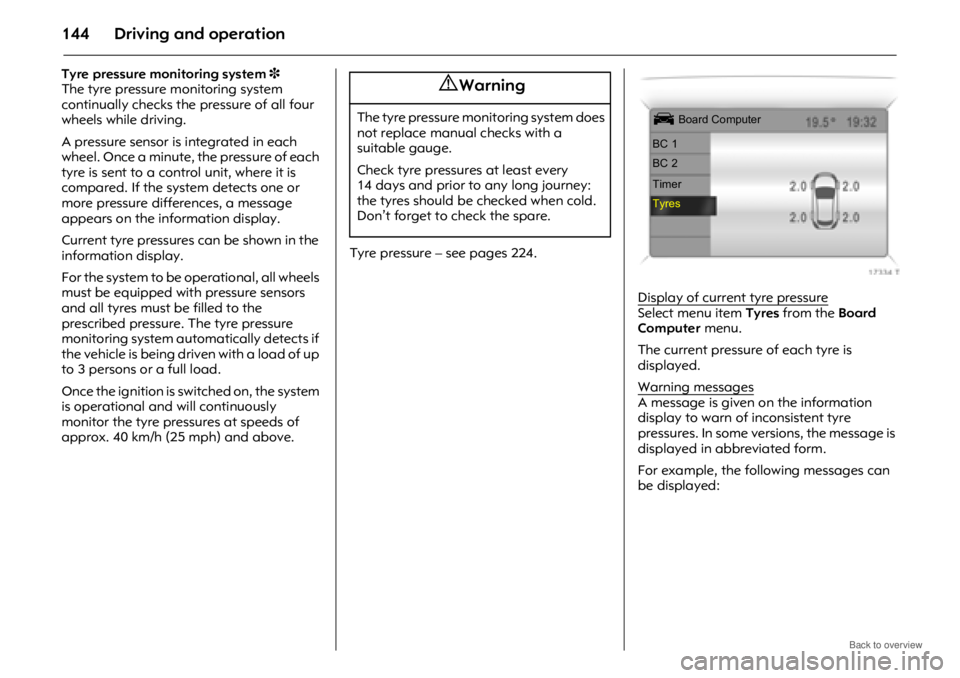
Driving and operation144
Tyre pressure monitoring system3
The tyre pressure monitoring system
continually checks the pressure of all four
wheels while driving.
A pressure sensor is integrated in each
wheel. Once a minute, the pressure of each
tyre is sent to a control unit, where it is
compared. If the system detects one or
more pressure differences, a message
appears on the information display.
Current tyre pressures can be shown in the
information display.
For the system to be operational, all wheels
must be equipped with pressure sensors
and all tyres must be filled to the
prescribed pressure. The tyre pressure
monitoring system automatically detects if
the vehicle is being driven with a load of up
to 3 persons or a full load.
Once the ignition is switched on, the system
is operational and will continuously
monitor the tyre pressures at speeds of
approx. 40 km/h (25 mph) and above. Tyre pressure – see pages 224.
Display of current tyre pressure
Select menu item Tyres from the Board
Computer menu.
The current pressure of each tyre is
displayed.
Warning messages
A message is given on the information
display to warn of inconsistent tyre
pressures. In some versions, the message is
displayed in abbreviated form.
For example, the following messages can
be displayed:
9 Warning
The tyre pressure monitoring system does
not replace manual checks with a
suitable gauge.
Check tyre pressures at least every
14 days and prior to any long journey:
the tyres should be checked when cold.
Don’t forget to check the spare. Ü Board Computer
BC 1
BC 2
Timer
Tyres
Page 145 of 234
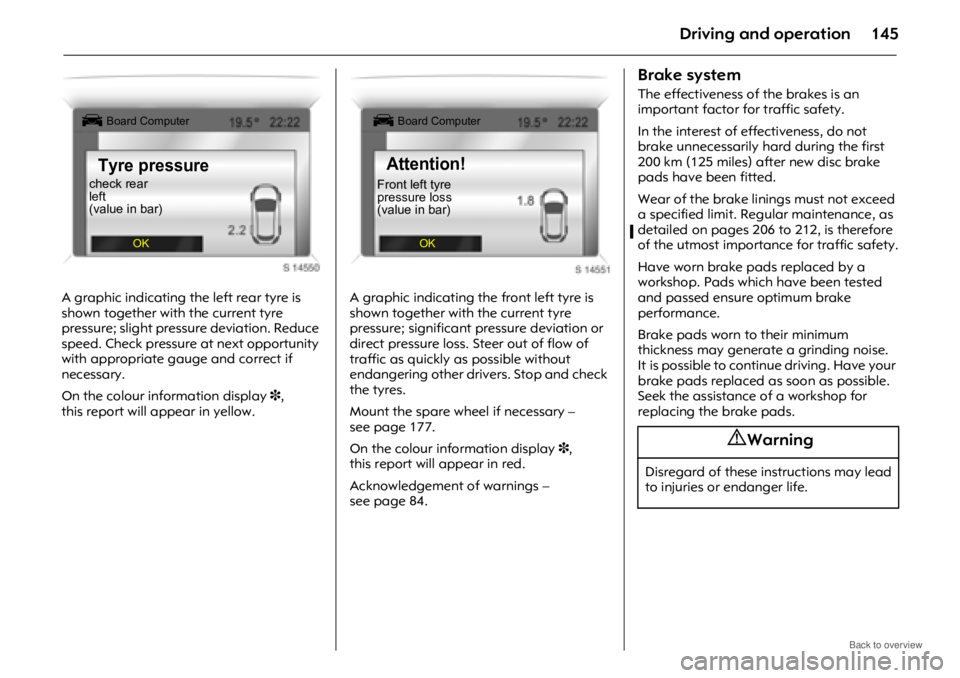
Driving and operation145
A graphic indicating the left rear tyre is
shown together with the current tyre
pressure; slight pressure deviation. Reduce
speed. Check pressure at next opportunity
with appropriate gauge and correct if
necessary.
On the colour information display 3,
this report will appear in yellow. A graphic indicating the front left tyre is
shown together with the current tyre
pressure; significant pressure deviation or
direct pressure loss. Steer out of flow of
traffic as quickly as possible without
endangering other drivers. Stop and check
the tyres.
Mount the spare wheel if necessary –
see page 177.
On the colour information display
3,
this report will appear in red.
Acknowledgement of warnings –
see page 84.
Brake system
The effectiveness of the brakes is an
important factor for traffic safety.
In the interest of effectiveness, do not
brake unnecessarily hard during the first
200 km (125 miles) after new disc brake
pads have been fitted.
Wear of the brake linings must not exceed
a specified limit. Regular maintenance, as
detailed on pages 206 to 212, is therefore
of the utmost importance for traffic safety.
Have worn brake pads replaced by a
workshop. Pads which have been tested
and passed ensure optimum brake
performance.
Brake pads worn to their minimum
thickness may generate a grinding noise.
It is possible to continue driving. Have your
brake pads replaced as soon as possible.
Seek the assistance of a workshop for
replacing the brake pads.
Ü Board Computer
Tyre pressure
OK
check rear
left
(value in bar)
Ü Board Computer
Attention!
OK
Front left tyre
pressure loss
(value in bar)
9 Warning
Disregard of these instructions may lead
to injuries or endanger life.
Page 146 of 234

Driving and operation146
Brake assist
Rapid powerful application of the brake
pedal automatically applies maximum
brake force amplification to achieve the
shortest possible braking distance under
full braking (brake assist).
Maintain steady pressure on the brake
pedal for as long as full-on braking is to
continue. When the brake pedal is
released, the maximum brake force
amplification is taken away.Foot brake
The brake system comprises two separate
brake circuits.
If one brake circuit should fail, the vehicle
can still be braked with the second
remaining circuit.
If this happens, the brake pedal must be
fully depressed with greater pedal
pressure. The distance required for braking
will be greater.
If, at any time during driving, the brake
pedal can be depressed further than
normal, the vehicle repeatedly pulls to one
side under braking or brake noise is heard,
consult a workshop.
In order to utilise the full pedal travel,
particularly in the event of a brake circuit
fault, there must be no mats in the area of
the pedals - see page 128.
With the engine stopped, the brake servo
assistance is discontinued after the brake
pedal has been depressed once or twice.
The braking effect is not reduced, but
increased foot pressure will be necessary.
Take extra care when the vehicle is being
towed.
Check the brake lamps before starting out
on a journey. Shortly after the start of each
journey, the brake system should be tested
for its effectiveness at low speed and
without inconveniencing other road users,
especially if the brakes are wet, e.g. after
washing your vehicle.
Excessive braking when going downhill can
cause brakes to temporarily overheat. Shift
to a lower gear rather than continuously
applying brakes.
The brake fluid level should be checked
regularly - see page 196.
Page 147 of 234

Driving and operation147
Hand brake
Always apply hand brake firmly. On slopes,
apply the hand brake as firmly as possible.
The mechanical hand brake acts on the
brakes on the rear wheels. It engages
automatically when applied.
To release the hand brake, press and hold
the button, pull the lever up slightly and
lower lever while holding the button in.
To reduce the operating forces of the
hand brake, depress the foot brake at the
same time. Control indicator
4 for brake system
Illuminates when ignition is switched on.
Extinguishes after engine is started.
Illuminates if hand brake is applied and/or
fluid level for brake hydraulics is too low.
Brake fluid level - see page 196. If the control indicator stays lit, the brakes
do not operate as normal or leaks are
found in the brake system, do not attempt
to drive the vehicle. Have the vehicle towed
to a workshop for inspection and repair.
If the control indicator does not illuminate
when the ignition is switched on or when
the hand brake is applied (with ignition
on), stop and consult a workshop.
9 Warning
If it illuminates when the hand brake is
not applied: stop vehi
cle, interrupt your
journey immediately.
Check brake fluid level and top-up if
necessary before consulting a workshop.
Have cause of brake fluid loss remedied.
Page 148 of 234
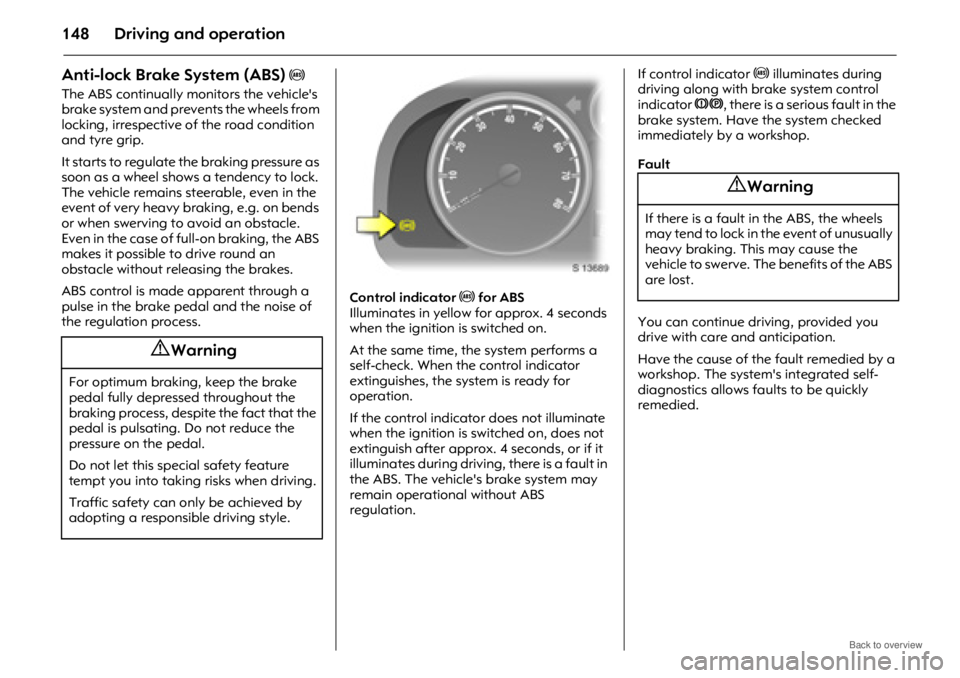
Driving and operation148
Anti-lock Brake System (ABS)
u
The ABS continually monitors the vehicle's
brake system and prevents the wheels from
locking, irrespective of the road condition
and tyre grip.
It starts to regulate the braking pressure as
soon as a wheel shows a tendency to lock.
The vehicle remains steerable, even in the
event of very heavy braking, e.g. on bends
or when swerving to avoid an obstacle.
Even in the case of full-on braking, the ABS
makes it possible to drive round an
obstacle without releasing the brakes.
ABS control is made apparent through a
pulse in the brake pedal and the noise of
the regulation process. Control indicator
u for ABS
Illuminates in yellow for approx. 4 seconds
when the ignition is switched on.
At the same time, the system performs a
self-check. When the control indicator
extinguishes, the system is ready for
operation.
If the control indicato r does not illuminate
when the ignition is switched on, does not
extinguish after approx. 4 seconds, or if it
illuminates during driving, there is a fault in
the ABS. The vehicle's brake system may
remain operational without ABS
regulation. If control indicator
u illuminates during
driving along with brake system control
indicator 4, there is a serious fault in the
brake system. Have the system checked
immediately by a workshop.
Fault
You can continue driving, provided you
drive with care and anticipation.
Have the cause of the fault remedied by a
workshop. The system's integrated self-
diagnostics allows faults to be quickly
remedied.
9 Warning
For optimum braking, keep the brake
pedal fully depresse d throughout the
braking process, despite the fact that the
pedal is pulsating. Do not reduce the
pressure on the pedal.
Do not let this special safety feature
tempt you into taking risks when driving.
Traffic safety can only be achieved by
adopting a responsible driving style.
9 Warning
If there is a fault in the ABS, the wheels
may tend to lock in the event of unusually
heavy braking. This may cause the
vehicle to swerve. The benefits of the ABS
are lost.
Page 149 of 234

Driving and operation149
Wheels, tyres
See page 223 for suitable tyres and
restrictions.
Factory-fitted tyres are matched to the
chassis and offer optimum driving comfort
and safety.
Changing tyre/wheel type
Note the necessary modifications before
switching to different tyres or wheels.
If wheel rims of a different type are to be
installed, the wheel nuts may also need to
be changed. We recommend you consult
an Opel Partner.
If tyres of a different size to those fitted at
the factory are used (this includes winter
tyres), the electron ic speedometer may
possibly need to be reprogrammed, to
ensure that the speed displayed is correct. Vehicles with tyre pressure monitoring
system
3
When using winter tyres, or when switching
to different tyre sizes, sensors for the tyre
pressure monitoring syst em can be fitted at
a later date by a workshop, upon request.
Otherwise, the system would not indicate
tyre pressure deviations.
Tyre pressure monitoring system -
see page 144.
Fitting new tyres
New tyres should be fitted in pairs, or, for
preference, in sets. Make sure that both
tyres on an axle are:
z the same size,
z the same design,
z the same make,
z and have the same tread pattern.
Fit directional tyres such that they roll in the
direction of travel. The rolling direction is
indicated by a symbol (e.g. an arrow) on
the sidewall.
Tyres fitted opposing the rolling direction
(e.g. when a tyre is changed) should be
refitted as soon as possible. This is the only
way to obtain full benefit from the design
properties of the tyre.
Observe legal requirements when
disposing of tyres. Some brands of tyres have a beaded edge
for alloy wheels, to protect against
damage. If wheel trims are used on steel
wheels with beaded-edge tyres, the
following procedure must be followed:
z
Wheel trims and tyres that are approved
by Opel for the respective vehicle and
comply with all of the relevant wheel and
tyre combination requ irements must be
used.
z If the wheel trims and tyres used are not
Opel-approved, the tyres must not have
a beaded edge.
9 Warning
Use of unsuitable tyres or wheels may
lead to accidents and render the vehicle
unroadworthy.
9 Warning
Use of unsuitable tyres or wheel trims
could lead to sudden pressure loss and
thereby accidents.
Page 150 of 234
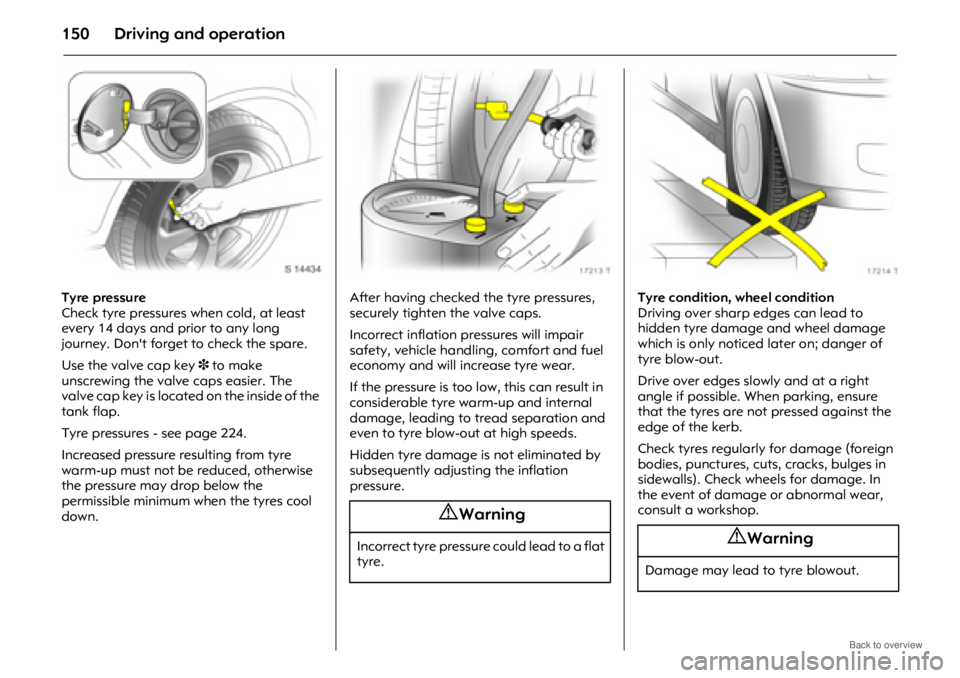
Driving and operation150
Tyre pressure
Check tyre pressures when cold, at least
every 14 days and prior to any long
journey. Don't forget to check the spare.
Use the valve cap key 3 to make
unscrewing the valve caps easier. The
valve cap key is located on the inside of the
tank flap.
Tyre pressures - see page 224.
Increased pressure resulting from tyre
warm-up must not be reduced, otherwise
the pressure may drop below the
permissible minimum when the tyres cool
down. After having checked the tyre pressures,
securely tighten the valve caps.
Incorrect inflation pressures will impair
safety, vehicle handling, comfort and fuel
economy and will increase tyre wear.
If the pressure is too low, this can result in
considerable tyre warm-up and internal
damage, leading to tread separation and
even to tyre blow-out at high speeds.
Hidden tyre damage is not eliminated by
subsequently adjusting the inflation
pressure.
Tyre condition, wheel condition
Driving over sharp edges can lead to
hidden tyre damage and wheel damage
which is only noticed later on; danger of
tyre blow-out.
Drive over edges slowly and at a right
angle if possible. When parking, ensure
that the tyres are not pressed against the
edge of the kerb.
Check tyres regularly for damage (foreign
bodies, punctures, cuts, cracks, bulges in
sidewalls). Check wheels for damage. In
the event of damage
or abnormal wear,
consult a workshop.
9 Warning
Incorrect tyre pressure could lead to a flat
tyre.9 Warning
Damage may lead to tyre blowout.